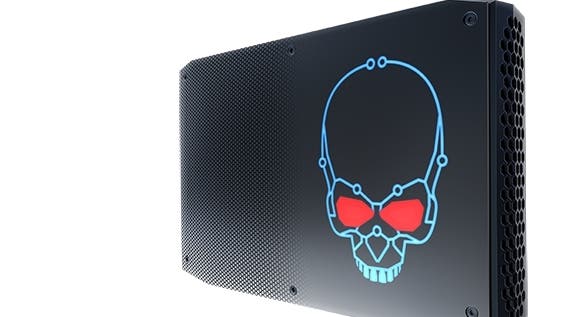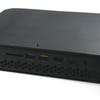Intel Hades Canyon NUC8i7HVK review: how powerful is the i7/Radeon Vega combo?
The great Intel/AMD hardware collaboration put through its paces.
After decades of fierce rivalry and bitter lawsuits, you'd be forgiven for thinking it would be a cold day in hell before Intel and AMD would team-up to produce a brand new kind of product, but here we are with Hades Canyon - a unique melding of Intel processor and AMD graphics technology. The NUC8i7HVK here is the top-end configuration, and the latest in a long line of ultra small form-factor PCs from Intel, the difference here being that alongside the quad-core, octo-thread Core i7 processor we have Radeon Vega graphics - a semi-custom design AMD has provided for Chipzilla. It's a cutting-edge piece of kit, but just how powerful is it?
First things first. While this is by far and away the fastest integrated graphics solution ever put out into the market, it shouldn't be compared with AMD's own Ryzen 3 2200G and Ryzen 5 2400G, each with their own integrated Vega GPU. AMD's processor is incorporated onto the chip die itself, sharing space - and memory bandwidth - with the x86 cores. It's a small, tight, all-in-one budget design.
The new Intel Kaby Lake G set-up is different: it's a premium piece of kit compromising of a four-core, eight-thread Intel processor like the many desktop Core i7s before it, sitting on what Intel calls an embedded multi-die interconnect bridge, which hooks up an entirely separate GPU chip to the CPU via eight PCI Express lanes. There's no memory contention or bandwidth limitations for the GPU as there is in the Ryzen APUs (where graphics run from the same system RAM as the CPU) and that's because 4GB of dedicated HBM2 is directly attached to the Radeon graphics core.
As for the Vega GPU, you get 24 compute units running at 1190MHz in this fully enabled version of the part, yielding 3.65 teraflops of compute power (a lower power 20CU variant with lower clocks is also available) while the 1024-bit HBM2 bus provides 205GB/s of bandwidth. That's not much from HBM2, but plenty for a GPU of this power level - and the decision to opt for this technology is all about tight, compact integration. This isn't an out-and-out power play from Intel then, despite its own benchmarks occasionally mentioning Nvidia's GTX 1060 Max-Q mobile technology. Instead it's about providing decent - if not spectacular - 1080p gaming in a form factor that'll scale from thin and light laptops to living room friendly PCs. It's also VR ready, thanks to its dual HDMI outputs and a convenient lowering of the Oculus VR entry spec.
In terms of the NUC8i7HVK itself, it's a curious design. The form factor of the box itself is rather cute, clearly in a different world to any current console design. However, it is supplied with a rather large external power brick, which isn't that much smaller than the main unit itself and rather spoils the overall effect of a tiny integrated machine. Where the NUC scores highly is in its port selection. The front of the unit sports an SD card slot, HDMI 2.0 output along with Thunderbolt over USB-C and two USB 3.0 ports - in addition to an IR sensor. The rear of the unit ups the ante still further, with two more USB-C ports, twin mini DisplayPorts, twin LANs, four more USB 3.1s and another HDMI 2.0 output.
It's a pretty remarkable showing overall, with the NUC able to offer up IO for virtually all scenarios. Our review unit was supplied pre-built by Intel, but internally there are two SODIMM sockets for memory and twin M.2 ports. The Core i7 8809G in our unit can turbo up to 4.2GHz, but runs at an all-core speed of 3.9GHz. It is overclockable, but the one weakness of the NUC is its thermal solution. Even at stock speeds, temperatures crept into 90c territory. Overclocking gains are limited to 200-300MHz, and to be honest, in our testing, what thermal headroom we had was better utilised by overclocking the Radeon GPU. Here, we could move from the NUC's default top-end of 1190MHz up to 1350MHz, but at this point, the machine becomes rather too loud, defeating the purpose of a small, discreet games unit.
In testing the NUC8i7HVK, we kicked off with CPU analysis - but to tell the truth, there isn't much of a story here. What you're effectively getting here is indeed a Kaby Lake quad-core i7, running at lower clocks than the desktop equivalent Core i7 7700K. Despite the drop in frequency, it packs a lot of processing power for such a small machine, and while the i7 brand has moved on to six-core, 12-thread monsters, there is more than enough gaming power to deliver the goods, especially when paired with this level of graphics.
Put simply, if it can handle the Crysis 3 jungle at 60fps at high settings, you're usually good to go and the NUC8i7HVK does indeed manage this. However, what is a little disappointing is the lacklustre support for faster DDR4 - our unit shipped with 2400MHz modules and based on the Intel spec, that's as fast it will go. Support for faster modules would mean more future-proofing in terms of the CPU's gaming performance, and as proven in the past, would deliver more if you're looking to overclock.
But really, it's the Radeon Vega graphics that are the star of the show here - though HBM2 memory controllers aside, some investigations have suggested that the GPU may be based more on the Polaris architecture, with no sign of Vega-specific features like half-float support (so-called 'rapid packed math') - something that is present and correct in the new Ryzen APUs with Vega graphics. Still, whether it's Polaris or Vega, 3.65 teraflops of power isn't to be sniffed at.
In benchmarking the GPU side of the equation, we stacked up the fully enabled RX Vega M GH GPU at the stock 1190MHz and the overclocked 1350MHz against the current desktop mainstream GPU champions: Nvidia's GTX 1050 Ti and GTX 1060, along with AMD's own RX 570 and RX 580. The latter two Polaris parts are clocked higher than the Vega M GH and have 32 and 36 compute units respectively, giving them a huge advantage over the NUC's 24 CUs. Our expectations weren't so high going in, and as Kaby Lake G is also aimed at mobile audiences too, we dug out some mobile GTX 1060 and Max Q results for a second series of tests (though reduced TDP on the KLG part will see reduced performance, of course).
Here's a look at the data and analysis we have for you over the following pages:
Hades Canyon vs GTX 1050 Ti/ GTX 1060/ RX 570/ RX 580
Hades Canyon vs Mobile GTX 1060/ GTX 1060 Max-Q Benchmarks
Conclusion
Click through for deep dive analysis, with full frame-rates and frame-times and a detailed breakdown of the performance metrics. Click on the bar charts for frame-rates and 'mouse over' performance comparisons, before reading the full conclusion.














